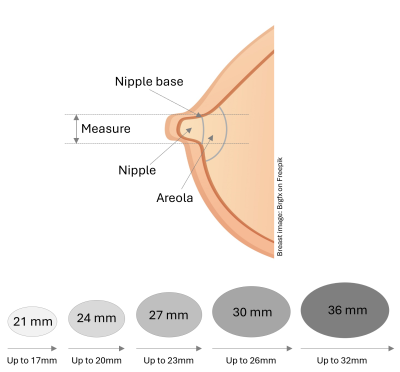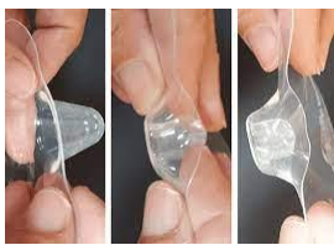About nipple shields
A nipple shield is a flexible silicone cover that can be placed over the nipple to help with breast-feeding if you are struggling to latch your baby due to a painful or flat nipple.
We use nipple shields when all other techniques have been tried and when milk supply is sufficient to flow through the shield.
Nipple shields should be used with caution and accompanied by a full feeding assessment by our clinical team for the following reasons:
- Nipple shields can reduce milk transfer to the baby and affect your oxytocin levels (a hormone produced during breast feeding).
- Infant sucking patterns are also changed when using a shield.
![]()
We do not recommend you use a shield in the first few days after birth when your body is producing colostrum (the first form of breast milk). Colostrum comes through in smaller quantities and thicker consistency, which makes it difficult for your baby to retrieve it through a nipple shield.
If you use a shield, do so on a strictly temporary basis.
Useful information
10% of the bacteria introduced to an infant comes from the skin around the mother’s areola (nipple area).
This can react with bacteria and saliva in the baby’s mouth to create a healthy environment, which may support their immune system.
If you can feed without the shield, your baby can gain benefits from skin-to-skin contact.
Sizing
A good fitting shield is important for milk flow and comfort. Use this guide.

How to attach the shield

- Turn the nipple shield almost inside out before applying it. This helps to draw your nipple in.
- Put it onto your nipple, then smooth the edges onto your breast.
- Use a few drops of water, nipple balm or expressed breast milk to secure the edges of the shield edge over the areola (see diagram under Sizing, above).
- If you are struggling to secure the shield, you can soak it in warm water first.
How to latch when using a nipple shield
Follow this guidance to latch your baby when using a nipple shield.
- Bring your baby to your breast while holding the shield in place with your thumb and finger.
- If you are using a nipple shield that has a cut-out, remember that the cut-out should be under the baby’s nose. This means that your baby can still smell your breast and have some skin contact.
- Place your baby so their nose is in front of your nipple.
- Bring your baby to your breast when they show a wide gape (open mouth) to allow your baby to have a deep latch on the shield. Placing some expressed breast milk inside the shield and on the tip can encourage your baby to latch on.
- If your baby is latched onto the shield properly, each suck will show visible movements in the part of your breast which is not attached to the shield.
- If there is little or no breast movement during sucking, your baby is on the tip of the nipple shield and you will need to reposition them.
Breast-feeding support
We will discuss feeding options with you in clinic.
Using a nipple shield may affect milk supply and affect your baby’s weight, so we will help you to regularly check this and all other signs that the baby is clinically well.
A member of the infant feeding team will watch your baby feeding using the shield, and complete an assessment. They will make a note of your baby’s sucking pattern to assess the amount of milk your baby is receiving.
If your baby appears to need more breast milk, we may encourage you to express milk after a breast feed, to empty your breast. You can then top up your baby with expressed breast milk.
Weaning off the shield
You can try to offer the breast without the shield as follows:
- at the beginning of a feed if your baby is calm and relaxed, or
- once let down has occurred (your milk has started to flow) and you hear your baby swallowing.
Remove the shield quickly and re-latch your baby immediately, or try towards the end of the feed without the shield.
Breast shaping (holding your breast with your hand) can help your baby to latch to the breast.
If your baby gets upset, you can always try another time.
Contact information
Infant feeding team